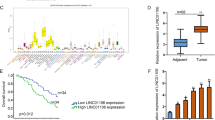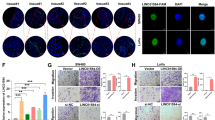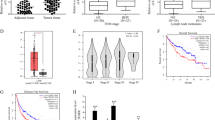Abstract
Colorectal cancer (CRC) is one of the most common human malignancies. An increasing body of evidence has revealed the important roles long noncoding RNA (lncRNA) plays in the growth dynamics of CRC cells. In this study, we aimed to define the role of LINC00337 in the malignant phenotypes, especially angiogenesis, of CRC and clarify the underlying molecular basis. Bioinformatic analyses identified promoter region methylation of CNN1 in CRC, which was further validated by BSP and MSP assays. Loss- and gain- of function approaches were used to determine the roles of CNN1 and LINC00337 in vitro and in vivo. MTT-based method, Transwell migration/invasion assays, and tube formation assay were adopted to evaluate the cancer cell proliferation, migration/invasion, and proangiogenetic potency respectively in vitro. The tumor growth, microvascular density (MVD) and markers of proliferation (Ki67) and angiogenesis (VEGF) were quantified in nude mice xenografted with CRC cells. It was found that CNN1 downregulation and LINC00337 overexpression occurred in CRC tissues and cells. Besides, the CNN1 promoter region was hypermethylated in CRC. CNN1 overexpression or LINC00337 knockdown restricted CRC cell proliferation, migration/invasion, and proangiogenetic potency in vitro, which was substantiated by the in vivo experiments evidenced by facilitated tumor growth and MVD as well as elevated Ki67 and VEGF. Furthermore, our mechanistic evidence revealed that LINC00337 recruited DNMT1 to the promoter region of CNN1 and restricted the transcription of CNN1. Taken together, this study indicates that LINC00337 facilitates the tumorigenesis and angiogenesis in CRC via recruiting DNMT1 to inhibit the expression of CNN1.
This is a preview of subscription content, access via your institution
Access options
Subscribe to this journal
Receive 12 print issues and online access
$259.00 per year
only $21.58 per issue
Buy this article
- Purchase on Springer Link
- Instant access to full article PDF
Prices may be subject to local taxes which are calculated during checkout







Similar content being viewed by others
Data availability
The datasets generated/analysed during the current study are available.
References
Siegel RL, Miller KD, Jemal A. Cancer statistics, 2015. CA Cancer J Clin. 2015;65:5–29.
van der Stok EP, Spaander MCW, Grunhagen DJ, Verhoef C, Kuipers EJ. Surveillance after curative treatment for colorectal cancer. Nat Rev Clin Oncol. 2017;14:297–315.
Sun D, Zhang F, Qian J, Shen W, Fan H, Tan J, et al. 4’-hydroxywogonin inhibits colorectal cancer angiogenesis by disrupting PI3K/AKT signaling. Chem Biol Interact. 2018;296:26–33.
Wu C, Zhu XT, Xia L, Wang L, Yu W, Guo Q, et al. High expression of long noncoding RNA PCNA-AS1 promotes non-small-cell lung cancer cell proliferation and oncogenic activity via upregulating CCND1. J Cancer. 2020;11:1959–67.
Xiong T, Huang C, Li J, Yu S, Chen F, Zhang Z, et al. LncRNA NRON promotes the proliferation, metastasis and EMT process in bladder cancer. J Cancer. 2020;11:1751–60.
Wang H, Zhang Y, Yang H, Qin M, Ding X, Liu R, et al. In vivo SELEX of an inhibitory NSCLC-specific RNA aptamer from PEGylated RNA library. Mol Ther Nucleic Acids. 2018;10:187–98.
Li Z, Wang Y, Hu R, Xu R, Xu W. LncRNA B4GALT1-AS1 recruits HuR to promote osteosarcoma cells stemness and migration via enhancing YAP transcriptional activity. Cell Prolif. 2018;51:e12504.
Hu B, Wang X, Li L. Long noncoding RNA LINC00337 promote gastric cancer proliferation through repressing p21 mediated by EZH2. Am J Transl Res. 2019;11:3238–45.
Guo Y, Wang M, Jia X, Zhu H, Zhi Y, Yuan L. Wnt signaling pathway upregulates DNMT1 to trigger NHERF1 promoter hypermethylation in colon cancer. Oncol Rep. 2018;40:1165–73.
Seo JS, Choi YH, Moon JW, Kim HS, Park SH. Hinokitiol induces DNA demethylation via DNMT1 and UHRF1 inhibition in colon cancer cells. BMC Cell Biol. 2017;18:14.
Ning X, Shi Z, Liu X, Zhang A, Han L, Jiang K, et al. DNMT1 and EZH2 mediated methylation silences the microRNA-200b/a/429 gene and promotes tumor progression. Cancer Lett. 2015;359:198–205.
Zhang X, Gong J, Lu J, Chen J, Zhou Y, Li T, et al. Long noncoding RNA LINC00337 accelerates the non-small-cell lung cancer progression through inhibiting TIMP2 by recruiting DNMT1. Am J Transl Res. 2019;11:6075–83.
Ayuk SM, Abrahamse H, Houreld NN. The role of photobiomodulation on gene expression of cell adhesion molecules in diabetic wounded fibroblasts in vitro. J Photochem Photobio B. 2016;161:368–74.
Wang S, Wu Y, Hou Y, Guan X, Castelvetere MP, Oblak JJ, et al. CXCR2 macromolecular complex in pancreatic cancer: a potential therapeutic target in tumor growth. Transl Oncol. 2013;6:216–25.
Takagi K, Takada T, Amano H, Yoshida M, Miura H, Toyota N, et al. Analysis of microvessels in pancreatic cancer: by light microscopy, confocal laser scan microscopy, and electron microscopy. J Hepatobiliary Pancreat Surg. 2008;15:384–90.
Drew JE, Farquharson AJ, Mayer CD, Vase HF, Coates PJ, Steele RJ, et al. Predictive gene signatures: molecular markers distinguishing colon adenomatous polyp and carcinoma. PLoS ONE. 2014;9:e113071.
Yamane T, Asanoma K, Kobayashi H, Liu G, Yagi H, Ohgami T, et al. Identification of the critical site of calponin 1 for suppression of ovarian cancer properties. Anticancer Res. 2015;35:5993–9.
Kim TK, Park CS, Jang J, Kim MR, Na HJ, Lee K, et al. Inhibition of VEGF-dependent angiogenesis and tumor angiogenesis by an optimized antibody targeting CLEC14a. Mol Oncol. 2018;12:356–72.
Lyko F. The DNA methyltransferase family: a versatile toolkit for epigenetic regulation. Nat Rev Genet. 2018;19:81–92.
Han G, Wei Z, Cui H, Zhang W, Wei X, Lu Z, et al. NUSAP1 gene silencing inhibits cell proliferation, migration and invasion through inhibiting DNMT1 gene expression in human colorectal cancer. Exp Cell Res. 2018;367:216–21.
Ji Q, Liu X, Han Z, Zhou L, Sui H, Yan L, et al. Resveratrol suppresses epithelial-to-mesenchymal transition in colorectal cancer through TGF-beta1/Smads signaling pathway mediated Snail/E-cadherin expression. BMC Cancer. 2015;15:97.
Jin KT, Yao JY, Fang XL, Di H, Ma YY. Roles of lncRNAs in cancer: focusing on angiogenesis. Life Sci. 2020;252:117647.
Wang Z, Li TE, Chen M, Pan JJ, Shen KW. miR-106b-5p contributes to the lung metastasis of breast cancer via targeting CNN1 and regulating Rho/ROCK1 pathway. Aging (Albany NY). 2020;12:1867–87.
Liu Y, Wu X, Wang G, Hu S, Zhang Y, Zhao SCALD1. CNN1, and TAGLN identified as potential prognostic molecular markers of bladder cancer by bioinformatics analysis. Med (Baltim). 2019;98:e13847.
Carmeliet P. VEGF as a key mediator of angiogenesis in cancer. Oncology 2005;69:4–10.
Navaneethan U, Zhu X, Parsi MA, Varadarajulu S. Pre-operative biliary drainage is associated with shortened survival time in patients with cholangiocarcinoma. Gastroenterol Rep. (Oxf). 2019;7:185–92.
Acknowledgements
We acknowledge and appreciate our colleagues for their valuable efforts and comments on this paper.
Author information
Authors and Affiliations
Contributions
XX and JN designed the study. LL and CD collated the data, FM and DS carried out data analyses and produced the initial draft of the manuscript. XX and JN contributed to drafting the manuscript. All authors have read and approved the final submitted manuscript.
Corresponding author
Ethics declarations
Conflict of interest
The authors declare that they have no conflict of interest.
Ethical approval
This study was performed under the approval of the Ethics Committee of Linyi People’s Hospital and all participated patients have submitted written informed consents. All animal studies were accomplished under the protocol approved by the Institutional Animal Care and Use Committee of Linyi People’s Hospital.
Additional information
Publisher’s note Springer Nature remains neutral with regard to jurisdictional claims in published maps and institutional affiliations.
Supplementary information
Rights and permissions
About this article
Cite this article
Xu, X., Nie, J., Lu, L. et al. LINC00337 promotes tumor angiogenesis in colorectal cancer by recruiting DNMT1, which suppresses the expression of CNN1. Cancer Gene Ther 28, 1285–1297 (2021). https://doi.org/10.1038/s41417-020-00277-2
Received:
Revised:
Accepted:
Published:
Issue Date:
DOI: https://doi.org/10.1038/s41417-020-00277-2
This article is cited by
-
Genome-wide screening for differentially methylated long noncoding RNAs identifies LIFR-AS1 as an epigenetically regulated lncRNA that inhibits the progression of colorectal cancer
Clinical Epigenetics (2022)
-
DNMT1-induced miR-378a-3p silencing promotes angiogenesis via the NF-κB signaling pathway by targeting TRAF1 in hepatocellular carcinoma
Journal of Experimental & Clinical Cancer Research (2021)



